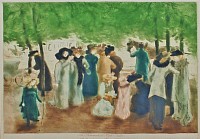BIOGRAPHY

Alfredo Muller (Italian/French 1869-1939)
Born in Leghorn, Italy into a well-off family, when he was very young he moved to Florence where he studied under Giuseppe Ciaranfi and Michele Gordigiani at the Accademia di Belle Arti. In 1886, when he was just seventeen, he exhibited with Fattori, Lega, Adolfo and Ludovico Tommasi at the "Prima Esposizione di Belle Arti" in Leghorn. In 1888, following bankruptcy, his family decided to move to Paris, where the young Muller studied under Francois Flameng, and from 1892, Carolus-Duran. However, he quickly learned the academic style of painting which favoured Impressionist techniques of light and colour, in particular Monet and Pissarro.
He lived in France until 1914, regularly traveling to Italy where he exhibited several times at the "Promotrice fiorentina", and it was precisely the 'French character' of six of his paintings exhibited in Florence in 1890-91, that provoked the worst criticism. Indeed late 19th century Florence was divided by Mullerism, young supporters of it including Nomellini, Ferruccio Pagni, Enrico Banti, Edoardo Gordigiani and Leonetto Cappiello and opponents of it being, for example, the elderly Fattori, who, in his famous letters written between January and March 1891, accuses Plinio Nomellini and "a group of scholars" of passively following the example of Muller and the trend of transalpine countries, turning their backs on their own artistic tradition.
Muller continued to exhibit and be successful in the Florence of the 90's. In 1891-92 he showed at the "Promotrice" and in 1896-97 at the "Festa dell'Arte e dei Fiori", with Impressionist style works. Returning to Paris in 1895 he made friends with Pissarro, Renoir, Lautrec and Cezanne. Cezanne in particular influenced Muller, the influence of Monet in his early works giving way to that of Cezanne in works exhibited in 1914 at the 2nd Secession in Rome.
In 1903 he stayed in London, married the artist Marguerite Thomann in 1908 and in 1913 took French citizenship. The following year on the outbreak of the First World War he moved to Italy, first to Taormina, later to Florence, to a villa at Settignano, where he lived until 1930. During these years he regularly took part in the town's exhibitions (such as the important "Primaverile fiorentina" in 1922) and the language of Cezanne in his works, like the articles published by Soffici in La Voce, helped to make the French artist known in Tuscany. Just as in the past, Muller's cultural publications aroused great interest in Florentine society. Together with his friend Edoardo Gordigiani, Muller contributed to the forming the collection of Egisto Fabbri, now lost, that included works by French artists including Cezanne and Van Gogh.
Muller's exhibition work continued in the years that followed: in 1914 he showed eleven works in a personal room at the Rome Secession, in 1922 he held a personal exhibition at the Galleria Pesaro in Milan and finally, in 1930, held another important personal exhibition at the Saletta Gonnelli in Florence, before moving permanently to Paris, where he died on 7 February 1939.
